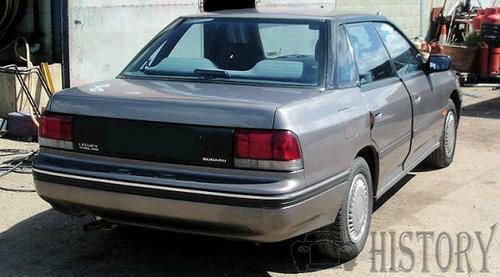Subaru Legacy first generation
 |
|
| Manufacturer | Subaru (Fuji Heavy Industries) |
|---|---|
| Also called | Isuzu Aska CX Subaru Liberty |
| Production | 1989-1994 |
| Successor | Legacy 2nd gen |
| Class | Compact Car |
| Body style | "B" pillar Hardtop and Wagon |
| Layout | FF layout standard F4 layout optional |
| Engine | 1.8 L EJ18 H4 2.0 L EJ20E H4 2.0 L EJ20D DOHC H4 2.0 L EJ20G DOHC turbo H4 2.2 L EJ22/E H4 2.2 L EJ22T turbo H4 2.2 L EJ22G DOHC turbo H4 (STi Touring Wagon) |
| Transmission | 4-speed automatic 5-speed manual |
| Wheelbase | 2,580 mm (101.6 in) |
| Length | 1993-94 Sedan: 4,540 mm (178.9 in) 1993-94 Wagon: 4,620 mm (181.9 in) 1990-92 Wagon: 4,600 mm (181.1 in) 1990-92 Sedan: 4,510 mm (177.6 in) |
| Width | 1,690 mm (66.5 in) |
| Height | 1993-94 Wagon: 1,390 mm (54.7 in) 1993-94 LS & LSi Wagon: 1,430 mm (56.3 in) 1990-92 Wagon: 1,420 mm (55.9 in) 1990-92 AWD Wagon: 1,440 mm (56.7 in) 1990-92 Sedan: 1,380 mm (54.3 in) 1990-93 AWD Sedan: 1,400 mm (55.1 in) 1993-94 Sedan: 1,360 mm (53.5 in) |
| Curb weight | 1,460 kg (3,220 lb) max |
The first generation Subaru Legacy is a mid-size family car developed by Fuji Heavy Industries. The Legacy was an all new model, and was considered a notable departure from Subaru products in the past.
History
The worldwide introduction of the Legacy was achieved in 1990. Subaru had earned a reputation of building vehicles that were regarded as "quirky" and other Asian manufacturers were bringing more upscale and conventional appearing models to the market. The Legacy appeared at the same time as the USA introduction of Lexus and Infiniti and five years after Acura, and it was interpreted by some as Subaru's attempt at participating in the emerging imported luxury car market. However, Subaru didn't have a V6 or V8 engine. The Legacy was more aerodynamic than previously built products, with soft edges and a more coherent appearance. The sedan has a break in the beltline where it drops down from the windshield to the front door glass, and then juts up from the rear door glass to the rear window, and the beltline is interrupted as it transitions down to the rear window on the wagon. The beltline treatment was used again on the SVX when it was introduced in 1992.
The Legacy broke with many Subaru traditions, such as no longer locating the spare tire in the engine compartment, behind the engine and above the transmission, a tradition started with the 1966 Subaru 1000, a method also used in the Citroën GS. The Legacy was also the second Subaru to use wheels with five lug nuts instead of four to better cope with the increased horsepower and torque from the powertrain. The Legacy was an all-new model, and was slotted at the top in Subaru's model range, joining the Leone, the Subaru XT coupe, Subaru Justy sub-compact, and the Subaru Rex and Subaru Sambar kei cars in Japan.
The Subaru star badge used since the introduction of the 360 was modified, with a more conventional and stylized appearance, in comparison to versions used on previous vehicles.
The Legacy began with a 5-door wagon or 4-door sedan body styles with FWD and an optional full-time AWD package, and was introduced in the United States, UK, Germany, the Benelux region of Northern Europe, Japan, Australia [where it was called Liberty] and New Zealand. The car was built with many luxury and technological advancements normally found on more expensive vehicles as standard equipment, such as power windows, central locking, fuel injection, air conditioning, vehicle speed sensitive, variable effort, power assist rack-and-pinion steering, alloy wheels, 4-wheel independent suspension (MacPherson struts in front and Chapman struts for the back) with both negative scrub and anti-dive and squat geometery, anti-sway bars front and rear, and 4-wheel disc brakes. Items that were optional that didn't make the vehicle too expensive were 4-channel ABS, licensed from Bosch and air suspension height control, which lowered the vehicle at speeds above 50 mph (80.5 km/h), and also allowed the driver to increase the vehicles ground clearance for off-road conditions. The air suspension was inspired by various manufacturers who used Hydropneumatic suspension, such as Citroen, Honda, and Mercedes-Benz.
On vehicles equipped with power central locking, the feature is activated from the inside drivers door lock switch only, by pushing the rocker switch to lock or unlock all doors. There is no label on any of the doors that suggest the door lock function is electric. Other doors can be locked or unlocked individually by pushing the respective door lock rocker switch, but it will not lock or unlock the other doors. The outside key door lock can unlock the drivers door only by turning the key partially, or with a complete turn to the left to unlock all doors.
According to a translation of the Japanese Wikipedia article on the Subaru Legacy, the Aomori Prefecture and Ibaraki Prefecture police departments have used the Legacy Turbo for patrol cars since the car was introduced and continue to do so. Also mentioned in this translation was an article stating that when Fuji Heavy Industries began to develop the Legacy during Japan's "bubble economy", the Subaru division was facing financial pressure to improve sales in larger car segments, due to market successes from other Asian competitors and that they used an internal project code of "44B" to refer to the Legacy.
Japanese models
When the Legacy was first introduced February 1, 1989 in Japan, the Legacy came in the following trim levels: the 220 PS (162 kW) DOHC 2.0-liter turbocharged "RS" with a 5-speed manual transmission only, followed by the "VZ" sedan and wagon and the "TZ" sedan and wagon with the 150 PS (110 kW) DOHC 2.0-liter engine. A smaller 102 PS (75 kW) SOHC 1.8-liter engine was used for the "Vi" sedan and wagon with FWD only, "Ti" sedan and wagon, the "Mi" and the entry level "Ei" sedans and wagons. The fuel efficiency for the 2.0-liter engine (non-turbo, manual transmission 4WD) is 10.8 km/L (31 mpg-imp; 25 mpg-US) based on Japanese Government emissions tests using 10 different modes of scenario standards, and 18 km/L (51 mpg-imp; 42 mpg-US) at speeds consistently maintained at 60 km/h (37.3 mph), based on figures listed in the Japanese sales brochure.
All wagons available to the Japanese were the extended roof version, referred to as the "Touring Wagon", and the air suspension, called "EP-S" (electronic pneumatic-suspension), was only available on the AWD equipped VZ wagon with an automatic transmission. In 1990, the 200 PS (147 kW) DOHC 2.0-liter turbocharged Legacy "GT" sedan/extended roof wagon was introduced, with a 4-speed computer-controlled automatic transmission only on the GT sedan and a choice of automatic or manual transmission on the wagon, as well as the slightly more affordable "RS type R" turbocharged sedan. The GT sedan/wagon, the RS, and RS type R came with 15-inch alloy wheels and 205/60R15 tires, dual piston brake calipers front and rear, and a sport-tuned suspension over the standard wheel size of 14-inch steel wheels for the other models offered. Plastic wheel covers were not offered on the entry level "Ei" sedan or wagon, and the 13-inch wheel was painted silver instead of black.
The "Ti type S" sedan and wagon, introduced in 1991, were offered with items available on the more expensive VZ and TZ but with the smaller 1.8 engine. The AWD setup, called "Active Torque Split" in Japanese language brochures, was standard on the Japanese-spec GT and RS, optional on the other trim levels with either a manual or automatic transmission. A partial 4WD system was offered on the lower trim level "Mi" and "Ei" sedans and wagons with a manual transmission only, activated by an imbedded switch on top of the gear shift lever. A glass moonroof was not available until 1990 on both the GT and VZ sedan and wagon.
At the Legacy's introduction, the top level VZ sedan interior was originally available in blue, gray or a special color combination of pearl white exterior paint with dark red upholstery and brown interior plastic, with the other sedans and wagons offering interior color choices of blue or gray. The VZ wagon that was painted black came with light gray two-tone paint scheme on the lower half of the vehicle, and both front and rear bumper covers below the bumper rub strip, which was later used when the Outback was introduced with the Second Generation. Blue interior was offered on vehicles with blue exterior paint only. When model year 1990 arrived, however, the interior color choices were reduced to gray for the entire product line, with various types of upholstery selections, including a choice of velour, moquette, or tricot cloth upholstery based on the trim level. Leather was optional on the GT sedan and wagon only. A four spoke, black leather covered MOMO steering wheel also came with the Japanese-spec GT sedan/wagon and the RS sedan, and was afixed with six allen head screws to an adapter hub that incorporated the cruise control activation switch. This arrangement allowed the exchange of other aftermarket steering wheels using a six screw installation pattern to suit personal tastes. The black leather steering wheel accompanied matching black leather on the gearshift, center armrest cover, and parking brake handle. The upper half of the dashboard on the 1990 RS was available with an optional blue color, with the rest of the dashboard and interior in gray only. The RS and RS type R interior color was black with black cloth upholstery with matching door panels and extended side bolsters on the front seats, covered in an upholstery pattern insert unique to the RS and RS type R. Japanese models have been known to be exported to countries with right-hand driving requirements, such as the UK, India, Australia and New Zealand.
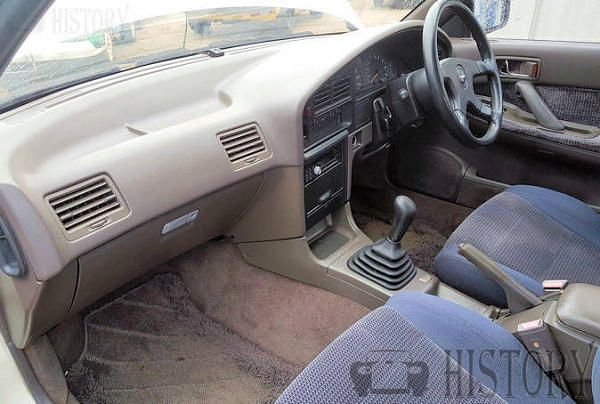
International models
The European, British and Australian versions were offered with three trim levels; the upscale GX, the more affordable LX in Australia called the GL in Europe and the UK, and the very basic DL in parts of Europe, with AWD offered as an option on the GX, LX and GL. In Europe and the UK, the GL and DL came with the 1.8-liter engine and the GX came with the larger 2.2-liter engine. For model year 1990, the British-spec. 1.8 GL was equipped with a carburetor and rear drum brakes but were later upgraded to single point fuel injection for model year 1991. The DL wasn't available in the UK or Australia. The British were also given a choice of vehicles equipped with a Catalytic Converter that restricted fuel usage to unleaded fuel only. The Australians could choose between the SOHC 2.2-liter no turbo on the GX and LX or the DOHC 2.0-liter with a turbo on the RS. In 1992, the Australians were offered the Liberty RS turbo as a sedan or extended roof wagon with a manual transmission only. When the Japanese-spec turbo was offered in Europe and Australia, the black leather covered MOMO steering wheel was also offered. The steering wheel was afixed with six allen head screws to an adapter hub that incorporated the cruise control activation switch, if cruise control was installed. This arrangement allowed the exchange of other aftermarket steering wheels using a six screw installation pattern to suit personal tastes. The black leather steering wheel accompanied matching black leather on the gearshift, center armrest cover, and parking brake handle. The main difference from the Japanese market MOMO steering wheel and the European and Australian version was the Japanese version was four spoke.
The European, British and Australian versions came with two interior color choices of blue or gray. European upholstery fabric selections of tweed, tricot, or webstoff woven cloth were particular to the individual trim level; tweed for the GX, tricot for the GL and webstoff for the DL. The British GL was offered with either the tricot or webstoff upholstery based on the exterior paint color chosen. Velour upholstery was offered instead of tweed on the Australian GX. The European and Australian versions were also available as a limited, premium editions, called GX Gala in Europe, and GX Heritage in Australia offering gray leather on the Euro-spec sedans and extended roof wagons, and only on the sedan for the Australian-spec Liberty Heritage. The European DL, which was very similar to the Japanese-spec Ei model, was very basic; items that weren't offered were a tachometer, power windows and central locking, a radio, individual 60:40 rear folding seatbacks on the sedan, and AWD was not available on the DL. The Euro-spec DL also didn't have plastic wheel covers, and instead was identical to the Japanese-spec Ei, with silver painted steel wheels and a silver plastic lug nut cover. The European DL also didn't have paint on the front or rear bumper covers, and remained in their natural state of black plastic.
The USA Legacy was introduced with three trim levels; the Standard, the "L" and the "LS" and in 1991 the Standard was removed and the "LSi" was introduced as a "LS" with gray leather interior on the sedan only, similar to the "Gala" and "Heritage" approach internationally. The USA-spec Standard was very similar to the Euro-spec DL and the Japanese-spec Ei, with a very sparse level of equipment. The 1990 models can be distinguished from the 1991 models by the color of the rub strip that encompases the vehicle; 1990 the color was gray and 1991 the color was black. Also, the color of the automatic front seat shoulder belt latch was interior color for 1990 and black for 1991 and subsequent years. For MY 1991, the "L" trim level was available with a Value Plus option package, which included anti-lock brakes, power windows, central locking, air conditioning, cruise control, and the 80W stereo. The 2.2 turbo, called the "Sport Sedan", was also introduced to the USA in 1991. The USA-spec Sport Sedan has Alcantara interior in gray and was not available in Japan, Europe or Australia.
Trim levels on the USA version can be easily identified by the color of the outside door handles. Base trim levels can be identified by chrome door handles, whereas uplevel had painted door handles that match the exterior color. Japanese models all had chrome door handles and European and Australian versions all had painted door handles. The USA door handle tradition continued until model year 2010 on the fifth generation Legacy platform, with Subaru using black plastic instead of chrome starting with 1994 Legacy lower trim levels. MY 1992 saw the Japanese-spec door handles changed to the European version of painted handles, a feature they still use on current models.
Specifications
Chassis types
| code | BC | BJ | BF |
|---|---|---|---|
| body styles | sedan | flat roof wagon | high roof wagon |
Engines
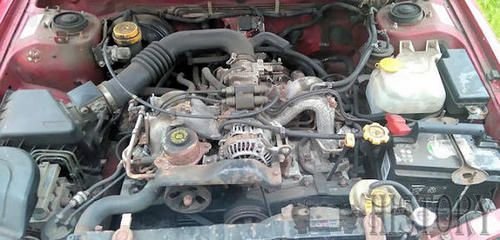
The EJ series flat-4 aluminium alloy engine, specially developed for the Legacy, was the most powerful engine Subaru had built to date, and the engine is currently offered in many configurations. In an attempt to ensure durability and longevity, Subaru chose to use five main crankshaft bearings. The engine has either single or double overhead camshaft architecture and pent-roof, cross flow cylinder firing chambers. The ignition utilized distributorless ignition, using a computer-controlled coil pack and spark plug wires to supply the electrical charge. Later versions of this engine used coil packs installed directly on top of the spark plug. Problems detected by the cars' on-board computers are signified by a "check engine" light, alerting the driver that maintenance is needed immediately. The air-fuel mixture is monitored by a mass air flow sensor and emissions are controlled by an oxygen sensor installed in front of a catalytic converter. It also uses reverse flow engine cooling, meaning cool water from the radiator entered the cylinder heads first and then exited through the top of the engine block back into the top of the radiator. The water flow was controlled by the thermostat which is located next to the water pump underneath the engine. Installing the thermostat in this position allows it to more accurately control the temperature of the water as it enters the engine from the cylinder heads first, thereby better preventing an occurrence of thermal shock.
When it debuted in the US, it was introduced with a slightly larger displacing SOHC 2.2-liter 135 bhp (101 kW; 137 PS) engine that was also used for the European, British and Australian versions over the Japanese market version of DOHC 2.0 liters. The 2.0-liter and 2.2-liter engines fuel delivery were managed with sequential multiport common rail fuel injection called MPFI, and the 1.8-liter engine used a throttle body fuel injection system with single injector called SPFI. The Japanese use the smaller engine because of Japanese vehicle size legislation, which determines the tax to be paid based on the cars dimensions and engine displacement. However, the Japanese domestic market (JDM) engine was more powerful, even without the turbo. The JDM DOHC 2.0-liter 148 bhp (110 kW; 150 PS) non turbocharged engine had a dual stage intake manifold where at approximately 3200-3500 engine RPMs four individual valves would allow additional air flow into the engine from a secondary manifold attached and located underneath the primary intake manifold.
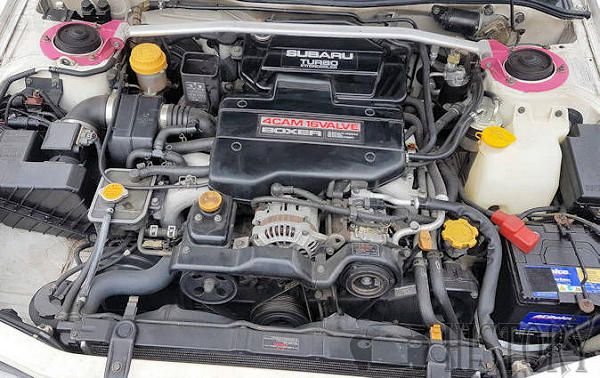
The DOHC 2.0-liter turbocharged 217 bhp (162 kW; 220 PS) EJ20G engine, which is a prized engine worldwide amongst Subaru enthusiasts, was introduced first in the Legacy and later used in the Impreza WRX when that model was introduced in 1993. In Europe, the Legacy RS Turbo was sometimes referred to as the "Lunacy" Turbo. The Australians were offered the Japanese-spec RS turbo sedan with the DOHC 2.0-liter engine in 1991, and Europe and the UK the same engine in 1992, manual transmission only. The DOHC 2.0-liter turbo also came with a water-cooled intercooler. The USA SOHC EJ22T 2.2-liter 163 bhp (122 kW; 165 PS) turbo was not offered the water-cooled intercooler when it was introduced to them in 1991. The USA turbocharged engine was available with either a manual or automatic transmission. The turbocharged engine was initially offered internationally in the sedan only, with Japanese buyers able to choose between a sedan or wagon on the GT starting in 1990.
All turbo models in North America ceased importation from Japan with the end of the first generation in model year 1994 until 2005, when the turbo was re-introduced. This was due to Subaru having upgraded the single turbo used in the Legacy with a twin turbo engine starting with the Second Generation and continued with the Third Generation. The twin turbo configuration was not compatible with left-hand drive vehicles because the turbo on the left side interferes with both the brake master cylinder and steering linkage, among other things.
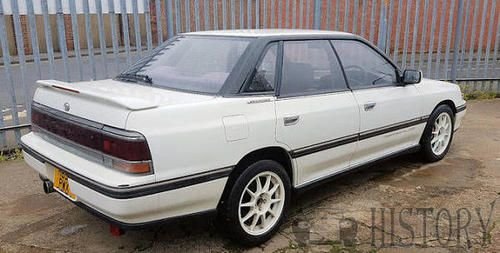
1991 facelift and other changes
A minor facelift to the front end came in 1991 for the 1992 model year, revising the grille, front fenders, hood and headlamps to provide a similar appearance with the introduction of the Subaru SVX luxury GT coupe, along with interior and exterior color changes. For MY 1994, the USA-spec wagons were available with minor trim packages, called the Alpine Sport and Sun Sport, which were basically "L" trim level wagons with optional equipment, such as heated front seats, added as a "Value Option Group" and also came with graphics denoting the package on the exterior of the vehicle. The USA-spec LSi wagon was available with tan leather interior, with matching leather on the steering wheel, gearshift selector, center armrest, interior door panels, and parking brake handle. The red plastic rear trim piece, on both the sedan and wagon, continues but the word "Subaru" is exchanged for the word "Legacy". Also, the Subaru star logo is no longer used on the back of the sedan or wagon.
Japanese models saw the introduction of the GT type S2 sedan, which added BBS alloy wheels and rear trunk spoiler as standard equipment, the VZ type R, and the Brighton 220, which had much of the luxury equipment from the VZ trim level and the 2.2 SOHC engine installed in only the Touring Wagon. The Japanese-spec TZ was replaced by the Brighton trim name. According to a translation of Wikipedia Japan of the Legacy, in August 1992, the "Legacy Touring Wagon STi" was released and limited to 200 units. A Nardi three spoke black leather steering wheel was installed with the "STi" logo on the center horn button. The only major upgrade mentioned was upgrading the fuel injection ECU, and increasing the turbocharger pressure from the standard 450 mmHg to 650 mmHg, which was being used on the "RS" sedan and the same engine torque output, with an automatic transmission only. This wagon used the EJ22G engine that was shared with the first GC8 series Impreza STi "22B". The 1989–1991 Japanese version incorporated the side repeater into the side of the front corner turn signal lens with the side repeater protruding from the lens so that it could be seen laterally, then later adopting the European configuration in 1992.
The 1989–1994 European and Australian Legacy had side repeater lenses installed in the front fender just behind the front wheel, with the front turn signals installed next to the headlights. Starting with the 1992 facelift, the European model sold in Germany was available in a "Hubertus 2" trim level on the 1.8 L wagon only; it was offered in green with a manual transmission, all-wheel drive was standard equipment with the dual range transmission, and was also fitted with a painted brush guard matching the body color that protected the front grille and headlights, wrapping around to protect the side turn signals. It was also fitted with the height adjustable air suspension, allowing the vehicle to travel off road. The name Hubertus is used by a German hunting knife manufacturer and the name Hubertus is the patron saint of hunters.
The front turn signals were relocated from underneath the bumper on USA versions to their new location next to the headlights, as in the Japanese, Australian and European versions. Side repeater lenses were also added to the USA version, but they were used as side marker lights and not turn signal repeaters.
In the USA, parking lights were installed next to the headlights for MY 1990–1991 within dedicated corner lenses, then incorporated with the front turn signals from 1992 to current models. Parking lights for European, Australian and Japanese versions were incorporated inside the headlights, on the outer edge. All international versions of the Legacy utilize a dedicated parking light switch installed on top of the steering column until model year 2010.
The facelifted Legacy appeared for model year 1992 only in Japan and Australia because the second generation was introduced in 1993, and it was also sold as the Isuzu Aska also for MY 1992.
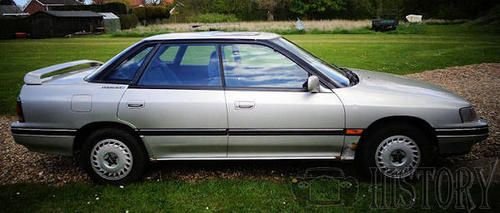
Motorsports
Just before the introduction of the Legacy to the USA, three Japanese-spec Legacy RS turbo sedans were sent to the FIA test track in Phoenix, Arizona, where they were driven at an average speed of 223.4 km/h (138.8 mph) for almost 19 days, accumulating 100,000 kilometres (62,000 mi) in that time, setting a new world record for land speed endurance, stopping only for fuel and routine service. Here's the documentary video, in Japanese, of the event
On another occasion, two AWD Legacy wagons finished 1st and 2nd place in the 1990 Alcan Winter Rally that covered 6,300 miles (10,100 km) from Seattle, Washington to the Arctic Circle and back and another wagon won the race again in 1992.
The Safari Rally event in 1990 saw two Subaru Legacys finish the race, with one car driven by Patrik Njiru winning in the Group N category. During the 1990 Safari Rally, 58 vehicles entered but only 10 cars crossed the finish line. Group N is a designation noting that the car is nearly identical to showroom models. The only modifications made are those required to meet safety regulations for the event. Another Group N Legacy finished the 1990 Acropolis Rally driven by Ian Duncan taking top honors and finishing the race in eighth place.
Technical
-
Technical specifications
Subaru Legacy 1st gen 1.8 SOHC (1989-1994)
No. of cylinders 4 OHC
Output: 76 (103 bhp) at 6000
Capacity 1820 cc
Compression ratio 1:9.7
Suitable for unleaded petrol Yes
Minimum octane rating 91 RON
Fuel system Make Hitachi Type DCY 340
Ignition coil Make Diamond Type E-083
Starter motor Make Nippon Denso
Maximum cranking amps 135-165 A
Alternator/Regulator Type Make Hitachi LR170-732B
Voltage regulator Type TRIZ-102
Regulated voltage 14.1-14.8 V
Parking brake travel No. of notches 7-8Subaru Legacy 2.2 Engine code: EJ22 (1989-1994)
No. of cylinders 4 OHC
Output: 100 (136 bhp) at 6000
Capacity 2212 (2179) cc
Compression ratio 1:9 5
Suitable for unleaded petrol Yes
Minimum octane rating 91 RON
Ignition coil Make Hitachi Type CM12-100
System pressurebar 2.4-2.7
Injector 11-12 Ohm
Compression pressure 11-13 bar
Oil pressure 3.0bar at 5000 rpm
Thermostat opens 76-80°CSubaru Model: Legacy (89-94) 2,0 Turbo Engine code: AY/EJ20-GN
Output: 147 (200bhp ) at 6000 rpm
No. of cylinders 4 DOHC
Capacity 1994 cc
Compression ratio 1:8 0
Suitable for unleaded petrol Yes
Minimum octane rating 91 RON
Air metering Type Mass
Firing order 1-3-2-4© Motor car
Service
-
Service instructions Subaru Legacy 1st generation
Subaru Legacy 1st gen 1.8 SOHC (1989-1994)
Firing order 1-3-2-4
Distributor Make Mitsubishi No.T2T 82371
Spark plugs Original equipment NGK BKR6E Electrode gap 0.8 mm
Spark plugs Make Bosch Type FR7DCX Electrode gap 1.1 mm
Spark plugs Make Champion Type RC7YCC4 Electrode gap 1.1 mm
Spark plugs Make NGK Type BKR6E-11 Electrode gap 1.1 mm
Fuel pump delivery pressure 0.18-0.24 bar
Compression pressure 10-12 bar
Oil pressure 3 bar at rpm5000
Thermostat opens 76-80 °C
Engine oil grade - cold climate 5W/30 SAE
Engine oil grade - moderate climate 10W/40 SAE
Engine oil grade - hot climate 20W/50 SAE
Engine oil with filter 4.5 litres
Manual gearbox oil grade 80W/90 SAE
Manual gearbox 4/5 speed 3.3 litres
Automatic transmission fluid Type Dexron II
Differential oil grade rear 80W/90 SAE
Differential oil rear 0.8 litres
Cooling system 6.4 litres
Brake fluid Type DOT 3/4
Power steering fluid Type Dexron II
Power steering fluid 0.7 litresSubaru Legacy 2.2 Engine code: EJ22 (1989-1994)
Engine oil grade - cold climate 5W/30 SAE
Engine oil grade - normal moderate climate 10W/30 or 10W/40 SAE
Engine oil grade - hot climate 20W/50 SAE
Engine oil with filter 4.5 litres
Manual gearbox oil grade 80W/90 SAE
Manual gearbox 4/5 speed 3.5 litres
Automatic transmission fluid Type Dexron II
Differential oil grade rear 80W/90 SA
Differential rear 0.8 litres
Cooling system 6.0 litres
Brake fluid Type DOT 3/4
Power steering fluid Type Dexron II
Power steering fluid 0.7 litres
Firing order 1-3-2-4
Spark plugs Original equipment NGK Type BKR6E
Electrode gap 0,8 -1.1 mm
Bosch Spark plug Type FR7DCX
Spark plugs Make Champion Type RC9YCC4
Spark plugs Make NGK Type BKR6E-11Subaru Model: Legacy 2,0 Turbo Engine code: AY/EJ20-GN (1989-1994)
Firing order 1-3-2-4
Spark plugs Original equipment NGK Type PFR6B
Electrode gap 0.8-1.1 mm
Spark plugs Make Champion Type RC7YCC
Spark plugs Make NGK Type BKR6EVX
Fuel system System pressure bar 2.4-2.7
Regulated pressure with vacuum bar 1.8-2.1
Injector 11-12 Ohm
Compression pressure 10-12 bar
Oil pressure 3bar /5000 rpm
Thermostat opens 76-80 °C
Engine oil grade cold climate 5W/30 SAE
Engine oil grade - normal climate 10W/30 or 10W/40 SAE
Engine oil grade - hot climate 20W/50 SAE
Engine oil with filter 5.2 litres
Manual gearbox oil grade 80W/90 SAE
Manual gearbox 4/5 speed 3.5 litres
Automatic transmission fluid Type Dexron II
Differential oil grade rear 80W/90 SAE
Differential rear 0,8 litres
Cooling system 7.2 litres
Brake fluid Type DOT 3/4
Power steering fluid Type Dexron II
Power steering fluid 0.7 litres© Motor car
